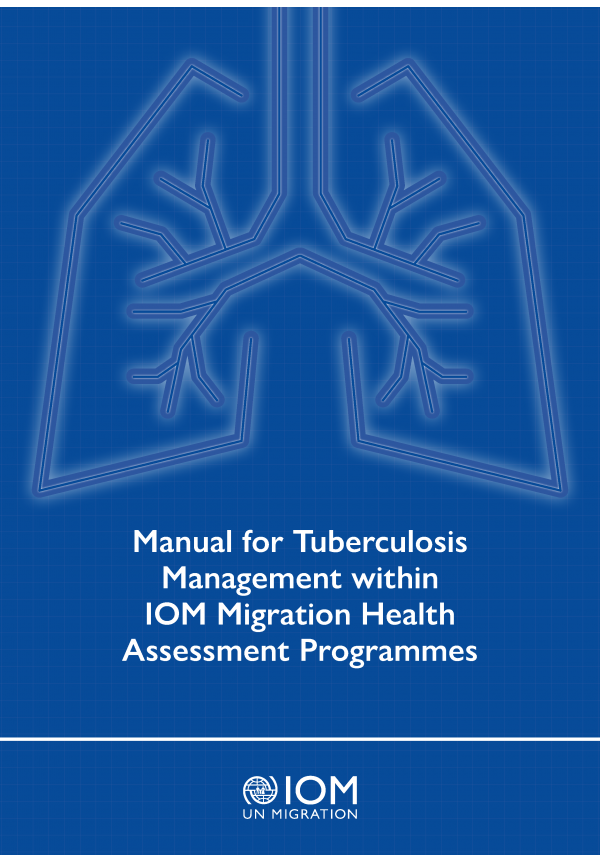
Original Language
English
ISBN (PDF)
978-92-9068-858-7
Number of Pages
168
Reference Number
PUB2020/067/L
Date of Publication
27 Aug 2020
Manual for Tuberculosis Management within IOM Migration Health Assessment Programmes
The management of tuberculosis (TB) by IOM aims to adequately treat and cure the infected patient, as well as minimize the risk of transmission to other persons before, during and after migration. Quality TB management requires the consistent and diligent application of a standardized, evidence-based approach along recognized guidelines. This manual aims to support a consistent and high-quality process of TB management for IOM health assessment activities worldwide.
Read More
- List of figures
- List of tables
- Acronyms and abbreviations
- Introduction
- Aim
- Technical instructions
- Reference guidelines
- General principles
- Chapter 1. TB Case Management: Roles and Responsibilities
- 1.1. Basic level: IOM refers for treatment without follow up and post-treatment evaluation
- 1.2. Monitoring level: IOM does not provide DOT, but provides monitoring throughout treatment and post-treatment evaluation
- 1.3. Comprehensive level: IOM fully manages TB treatment
- 1.4. Individual roles and responsibilities
- Chapter 2. Initiating treatment
- 2.1. Screening programmes
- 2.2. TB screening algorithm
- 2.3. Newly diagnosed cases
- 2.4. Cases of ongoing TB treatment
- 2.5. Isolation
- 2.6. Initial administrative requirements
- 2.7. Additional administrative requirements when IOM provides treatment
- Chapter 3. Pre-Treatment Work Up
- 3.1. Counselling
- 3.2. Medical history review, physical examination and vital signs
- 3.3. Baseline investigations
- Chapter 4. Contact Tracing and Latent TB Infection
- 4.1. Evaluating and managing TB contacts as part of the Migration Health Assessment and resettlement processes
- 4.2. Treating latent TB infection
- 4.3. Country-specific requirements for managing latent TB infection
- Chapter 5. Treatment
- 5.1. General treatment processes
- 5.2. Mode of TB treatment delivery: directly observed versus self-administered
- 5.3. Delivering and organizing DOT
- 5.4. Client-centred TB case management
- 5.5. Anti-TB medicines
- 5.6. Drug-susceptible TB
- 5.7. Paediatric TB cases
- 5.8. Treatment extensions
- 5.9. Treatment interruptions
- 5.10. Patients with TB−HIV co-infection
- 5.11. TB treatment and hepatic disease
- 5.12. Pre-existing hepatic disease
- 5.13. TB treatment and renal disease or insufficiency
- 5.14. TB treatment for pregnant and breastfeeding women
- 5.15. Regimens for drug-resistant TB
- 5.16. Schedules for follow-up tests for different countries
- 5.17. Monitoring and managing side effects
- 5.18. Default tracing
- 5.19. Clinical consultations
- Chapter 6. Drug-resistant TB
- 6.1. Molecular testing
- 6.2. Drug-susceptibility testing on liquid and solid media
- 6.3. Empiric identification
- 6.4. Treatment monitoring for drug-resistant TB
- 6.5. Treatment regimens for drug-resistant TB
- 6.6. Building a longer treatment regimen for multidrug-resistant TB
- 6.7. Using the standardized shorter regimen to treat multidrug-resistant TB
- Chapter 7. Treatment Monitoring
- 7.1. Monitoring adherence to treatment
- 7.2. Monitoring side effects
- 7.3. Monitoring treatment effectiveness
- Chapter 8. Documentation and Reporting
- 8.1. Responsibility
- 8.2. Documentation
- 8.3. Data entry procedure
- 8.4. Data validation and IOM internal reporting
- 8.5. Reporting obligations
- Chapter 9. Treatment completion and certification
- 9.1. Treatment outcomes
- 9.2. Certification
- Chapter 10. Psychosocial management
- 10.1. Background
- 10.2. Psychosocial support
- Chapter 11. TB Infection Prevention and Control
- 11.1. Administrative infection control measures
- 11.2. Environmental infection control measures
- 11.3. Respiratory protection measures
- 11.4. Measures for congregate settings
- Annexes
- Annex 1. Global Drug Facility Process
- Annex 2. Individual Staff Roles and Responsibilities for Managing TB for IOM Clients
- Annex 3. TB Flow Process Schematic
- Annex 4. Table of Country Screening Requirements
- Annex 5. MiMOSA Guide for MHD Users
- Template Forms
- Template Form 1. TB Treatment Referral Summary
- Template Form 2. Treatment Monitoring Advice for External Physicians
- Template Form 3. National TB Programme Notification
- Template Form 4. TB Counselling and Consent
- Template Form 5. TB Patient Treatment Record
- Template Form 6. TB Patient Appointment Card
- Template Form 7. TB Treatment Compliance
- Template Form 8. TB Side Effect Monitoring
- Template Form 9. Form for HIV Counselling and Consent for HIV Testing for TB Patients
- Template Form 10. Checklist for TB Monitoring
- Template Form 11. Baseline and Routine Monitoring of MDR-TB Requirements
- Template form 12. Sputum Results Summary
- Template Form 13. Chest X-Ray Results Summary
- Template Form 14. TB Treatment Certificate